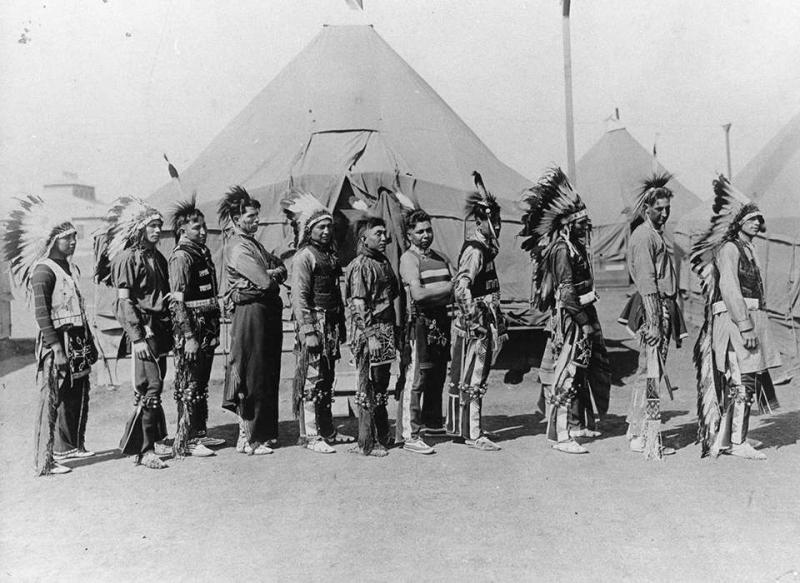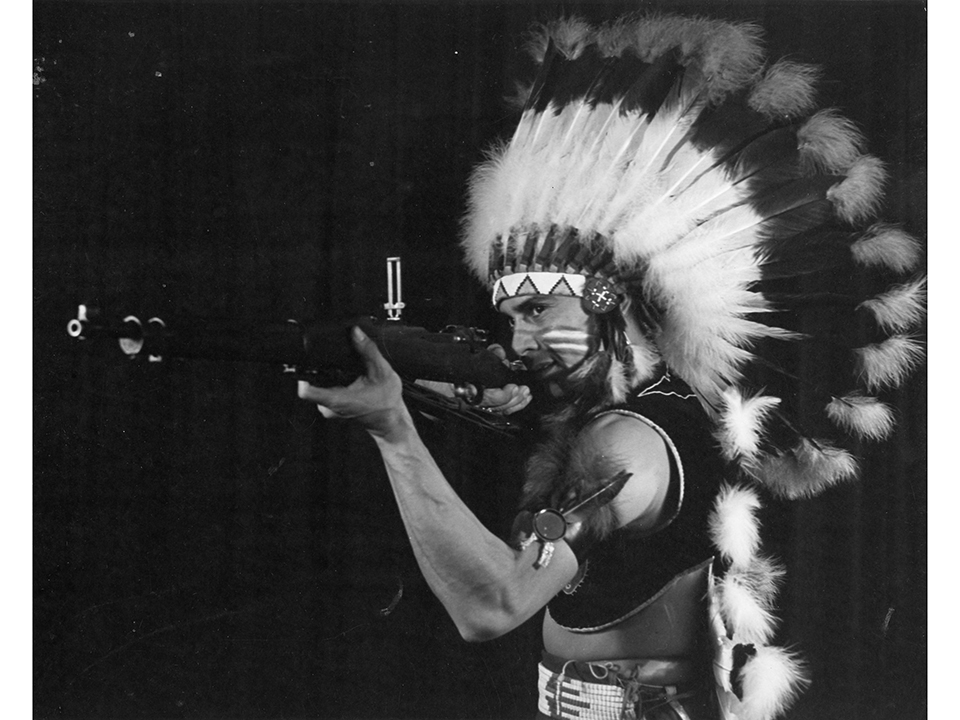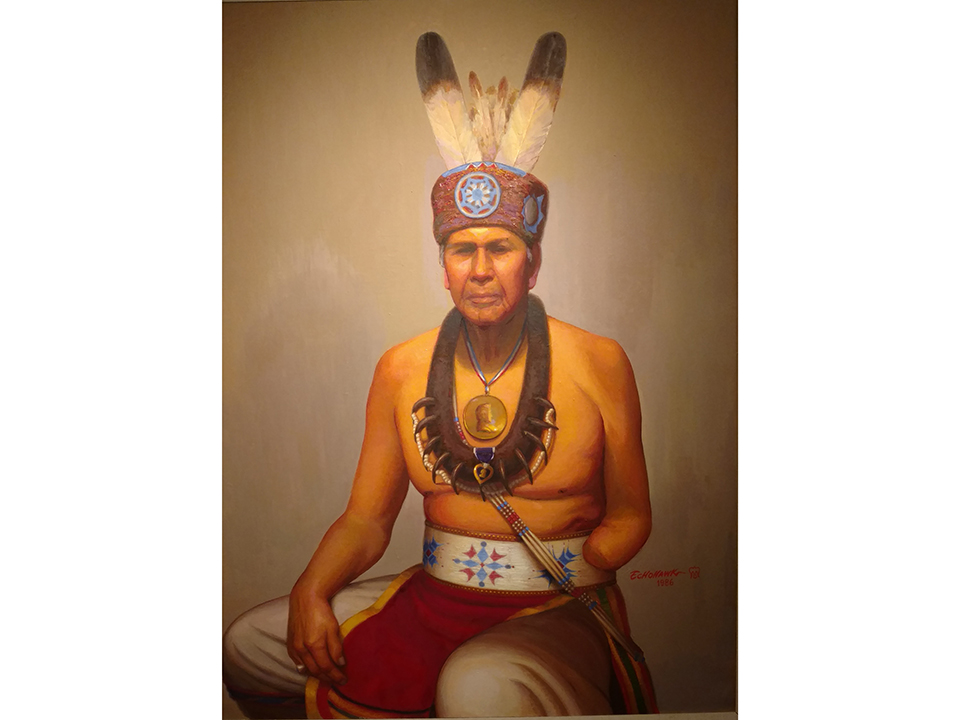American Indians in the 45th Infantry Division

Since its inception, Native Americans from the tribes of Oklahoma have served in the National Guard with pride and honor. During World War I, Colonel A. W. Bloor, commander of the 142nd Infantry, 36th Division, tested and deployed a code, using the Choctaw language in place of regular military code. Many of the Choctaw code talkers were members of the Oklahoma National Guard. Bloor would give his orders to the Indians in English. They would translate them into Choctaw for transmission, after which the message would be retranslated into English. It was an effective communication device and a practice that continued during World War II.
After the First World War, the National Guard was reorganized under the National Defense Act of 1920. The legislation had far-reaching effects on the Oklahoma National Guard. The act led to the formation of the 45th Infantry Divisions, which comprised of National Guard units from Oklahoma, Colorado, New Mexico, and Arizona. With a high percentage of Native people living in these states, the 45th's Indigenous ranks continued to grow. Even the shoulder-sleeve patch and distinctive unit insignias for the division were steeped in Native American iconography.
Among the Indigenous soldiers serving in the Oklahoma National Guard were young men who had attended the Chilocco Indian Agricultural School in Oklahoma. The boarding school system for Native Americans was fraught with problems, including cultural genocide. However, the military discipline employed by school administrators did prepare students for service in the Armed Forces. Furthermore in Oklahoma, C Company, 180th Infantry Regiment, 45th Infantry Division, was located on the Chilocco campus. Many of the Indigenous soldiers from Oklahoma that served in World War II were members of the 180th, including Medal of Honor recipients Ernest Childers (Muscogee-Creek) and Jack Montgomery (Cherokee). Even the famed World War II cartoonist Bill Mauldin was influenced by the Indians serving with the 45th Division. Mauldin's military career began with the 45th. His cartoon character Willie was inspired by fellow soldier, Rayson Billey, a Choctaw Indian from Keota, Oklahoma.
The 45th Division was called into federal service in September 1940 to train for possible US engagement in World War II. At the time, there were approximately 2,000 Native Americans representing 50 tribes serving in its ranks. Training first at Fort Sill, Oklahoma, the 45th’s ranks slowly began to swell with non-guardsmen from across the country. By the time the Thunderbirds reached Fort Devens, Massachusetts, in the spring of 1942, the division consisted of men from 47 states. However, that did not mean that the impact of American Indian soldiers was diminished. Still, before they proved their mettle in battle, they had to overcome stereotypes and racist attitudes while training stateside.
 Dave Cummings (Muscogee-Creek) Fort Devens, 1942. Courtesy of the 45th Infantry Division Museum.
Dave Cummings (Muscogee-Creek) Fort Devens, 1942. Courtesy of the 45th Infantry Division Museum.
After the division left Fort Sill to train at Camp Barkeley near Abilene, Texas, the Native Americans serving with the Thunderbirds attracted little notice. However, in Massachusetts, and later New York, the Native American soldiers were met with trepidation by the local community. As Sergeant Don Robinson wrote in his book News of the 45th ,
"It seems that the New Englanders were afraid of our Indians. People would cross the street to avoid meeting these peaceful farmers, lawyers, oil field workers, and businessmen who made up our large Indian contingent."
Sergeant Don Robinson
There can be little doubt that the perceptions of Native Americans were formed through pop culture representations in the movies and dime store novels. However, rather than shrink from view, the Native Americans took the opportunity to educate the public about Indigenous culture and put to rest the notions that they were "blood-thirsty savages."
Indigenous Thunderbirds from Oklahoma and New Mexico made dance regalia, drums, and flutes. They began to perform ceremonial songs and dances at schools for Boy Scout troops, at churches, and other civic institutions, as well as USO shows and war bond rallies. The performances captured the imagination of many and ultimately led communities to understand Native American culture better. By the time the Thunderbirds left for Sicily's shores in June 1943, the Indian dancers had performed for an estimated 400,000 people. The local newspapers did not miss an opportunity to report on this unique form of entertainment, and the New Englanders gained a newfound respect for the Native American soldiers of the division.
While the dancers performed, the division's Native Americans also excelled in their military training. Secretary of War Henry L. Stimson observed Chauncey Matlock (Pawnee) instructing soldiers in the use of bayonets. He stopped to compliment him. Remarking that Matlock was the "finest instructor in bayonet practice, I have ever seen." The Indigenous Thunderbirds also excelled in rapidly rising through the ranks. Major Lee Gilstrap of the division noted that "The Indians make such fine soldiers. We have Indian officers holding ranks as high as lieutenant colonel."
The American Indians of the 45th Infantry Division left their mark on New England. They also made an impression overseas during the division's 511 days in combat. Three of the division's eight Medal of Honor recipients were Native Americans. Ernest Childers, C Company, 180th Regiment, was honored for his exceptional bravery near Oliveto, Sicily, on September 21-22, 1943. Jack Montgomery, I Company, 180th Regiment, was recognized for his heroic efforts at Anzio near Padiglione on February 22, 1944. Van T. Barfoot (Mississippi Choctaw), I Company, 157th Regiment, received his Medal of Honor for actions near Carano, Italy, on May 23, 1944.
Although the Navajo code talkers' wartime exploits are well-known, they were not alone in the use of their Native language in America's military. The Pawnee code talkers transmitted, received, and encrypted sensitive tactical messages in the Pawnee language. Seven of the nine Pawnee code talkers served with the 45th Infantry Division. Staff Sergeant Frank Davis, Sergeant Brummett Echohawk, Sergeant Grant Gover, Staff Sergeant Phillip Gover, Staff Sergeant Chauncey F. Matlock, Sergeant Harold W. Morgan, and Master Sergeant Floyd E. Rice were formally recognized for their WWII contributions in 2013 when they received the Congressional Gold Medal. They were inducted into the Oklahoma Military Hall of Fame in 2015.

Portrait of Phillip Gover (Pawnee), WWII Code Talker, by fellow Thunderbird Brummett Echohawk (Pawnee). Courtesy of the 45th Infantry Division Museum.
When World War II came to an end, the 45th Infantry Division once again faced reorganization. The Thunderbirds were no longer a multi-state entity; instead, the division would solely represent the Oklahoma National Guard. Native Americans remained a vital part of their ranks. Some men served in both World War II and Korea. O.T. Autry (Muscogee-Creek) began his service with the 45th, serving with the 189th Field Artillery Battalion. During the Korean War, he was commander of the 189th. His service to the Oklahoma National Guard spanned 34 years. He worked his way up the ranks to become the division artillery commander and obtained the rank of brigadier general. His outstanding and heroic service earned him the Silver Star, the Bronze Star, two bronze arrowhead for amphibious landings, and 10 battle stars for campaigns in the two wars.
Like Autry, Hal Muldrow (Choctaw) began his military career in the field artillery during World War II. He was the commander of the 45th Infantry Division field artillery during the Korean Conflict. Muldrow was promoted to major general in 1952 and was the commander of the 45th Infantry Division, Oklahoma National Guard until his retirement in 1960. During his career, he was awarded the Silver Star, Bronze Star with oak leaf cluster, American Defense Medal; EAME Theatre Ribbon with eight battle stars, Legion of Merit, United Nations Campaign Service Medal, Korean Campaign Service Medal with three bronze battle stars, and the Korean Presidential Unit Citation.
The 45th Infantry Division was deactivated in 1968; however, their lineage and honors are carried on within the Oklahoma National Guard units. Oklahoma's Indigenous citizens, men and women, continue to serve their state and their country with distinction.
To learn more, please visit the 45th Infantry Division Museum .
Tags
Who is online
44 visitors

Something many don't know is that 25% of Native American males serve/served in our armed forces.
Why would so many serve in a country's military of the country who has tried it damnedest to exterminate their people?
Because we were defending their homeland and know good from evil.
It is an incredible testimony to the patriotism of Native Americans. I regret to admit that I have learned a lot about this patriotism within the past few years. The bravery, we always knew about.
Believe it or not Vic, I really appreciate your words.
I could be wrong, but I believe you mentioned you were in the NE side of the world. If so, there are tons and tons of source materials available for a deeper understanding - if you so desire.
That is where I live. I've read a few things, only after I got to know you. All my life I never even thought much about it. I hate to admit that. That being said, I had reason to visit New Mexico on a few occasions. (It truly is the land of enchantment). Second on my list was meeting Native Americans and visiting a few places that were part of that heritage such as the Aztec Ruins National Monument. I do have pictures from those trips. One day I'll upload them.
If ya make it out this way again, be sure to visit Taos and Santa Fe - 'specially the Blue Lake area.
Will do!
A most excellent article 1st. Thank you.
I love the photos. I think the subject of American Indians serving in such great numbers in the US military is a topic that never gets old.
John, on this we definitely agree.
Great article 1st. I love the photos. I have never seen them before. You have to love the Dave Cummings in full regalia.
And, you betcha he was indeed a crack shot with that lil' M-1 Garand
Garand's were not so little. It was very accurate but it took a lot of practice to be a crack shot with it! Not very many people were.
Good article but they left out a couple of important things with the 45th. The divisional patch was the Swastika (pictured below know as the Whirling Logs by NA's) which has been used by American Indians for centuries. When it was co-opted by the Nazi's the patch was changed to the NA Thunderbird (1939). See below it is also the symbol of the Ojibwe Nation.
Thanks Kavika - as you said, there are many stories unheard/unknown regarding Native Americans - their history, culture, traditions, religions, heritages and constant tenacity of always trying to do good for the growth/development of the Seven Generations.
I believe you have posted stories/articles of the 45th in the past - fantastic history from, IMHO, the Master in story-telling.
Before Hitler , the Swastika was widely used by many cultures in both South as well as eastern Asia. And it had a very positive meaning-- a symbol of good luck among other things!
There's even a common Yoga pose named after it it (IIRC, yoga poses have Sanskrit names, usually named after forms in nature, both plants and animals).
I'm not sure of the original derivation of the name of that shape, but this pose which some feel resembles the Swastika shape is called "Swastikasana" ("asana" simply means "pose"-- so the English translation of Swastikasana is "Swastika Pose" or "Auspicious Pose" as I believe the orioginal meaning of "Swastika" is "Auspicious"):
Its an ancient symbol-- even found in Israel!
.
Also commonly used in some Buddhist Temples: